You He
Plug-and-Play Clarifier: A Zero-Shot Multimodal Framework for Egocentric Intent Disambiguation
Nov 12, 2025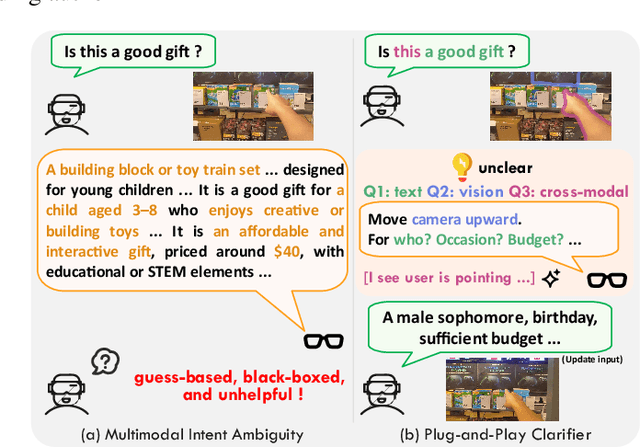
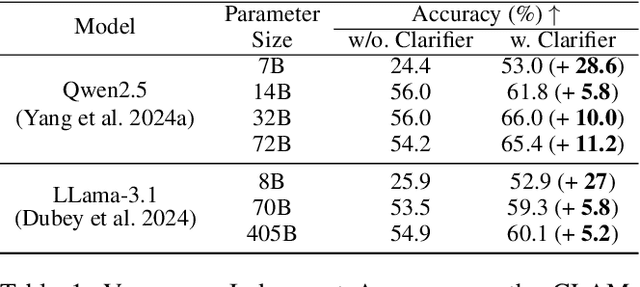
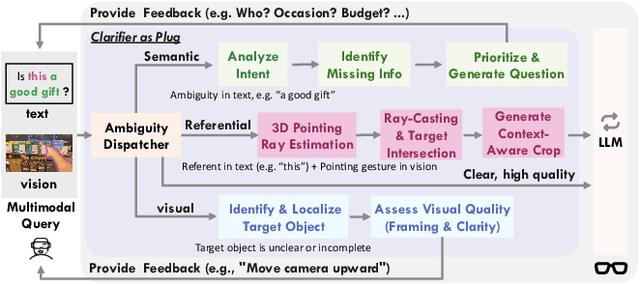
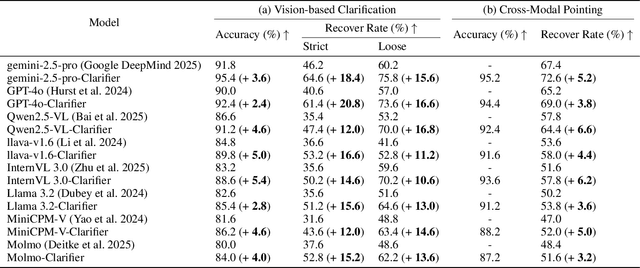
Abstract:The performance of egocentric AI agents is fundamentally limited by multimodal intent ambiguity. This challenge arises from a combination of underspecified language, imperfect visual data, and deictic gestures, which frequently leads to task failure. Existing monolithic Vision-Language Models (VLMs) struggle to resolve these multimodal ambiguous inputs, often failing silently or hallucinating responses. To address these ambiguities, we introduce the Plug-and-Play Clarifier, a zero-shot and modular framework that decomposes the problem into discrete, solvable sub-tasks. Specifically, our framework consists of three synergistic modules: (1) a text clarifier that uses dialogue-driven reasoning to interactively disambiguate linguistic intent, (2) a vision clarifier that delivers real-time guidance feedback, instructing users to adjust their positioning for improved capture quality, and (3) a cross-modal clarifier with grounding mechanism that robustly interprets 3D pointing gestures and identifies the specific objects users are pointing to. Extensive experiments demonstrate that our framework improves the intent clarification performance of small language models (4--8B) by approximately 30%, making them competitive with significantly larger counterparts. We also observe consistent gains when applying our framework to these larger models. Furthermore, our vision clarifier increases corrective guidance accuracy by over 20%, and our cross-modal clarifier improves semantic answer accuracy for referential grounding by 5%. Overall, our method provides a plug-and-play framework that effectively resolves multimodal ambiguity and significantly enhances user experience in egocentric interaction.
A Survey of Multi-sensor Fusion Perception for Embodied AI: Background, Methods, Challenges and Prospects
Jun 24, 2025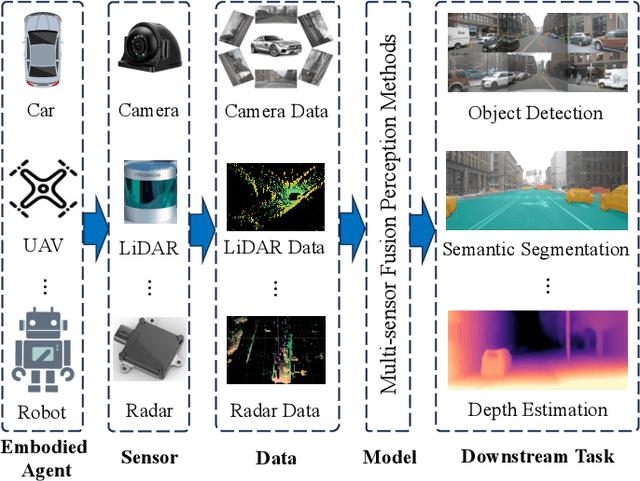

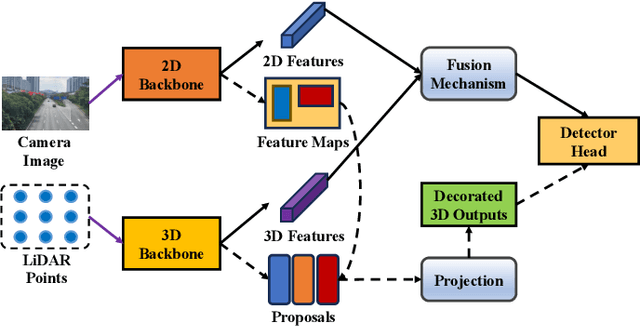
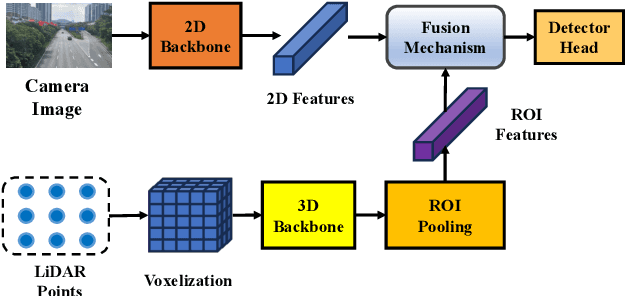
Abstract:Multi-sensor fusion perception (MSFP) is a key technology for embodied AI, which can serve a variety of downstream tasks (e.g., 3D object detection and semantic segmentation) and application scenarios (e.g., autonomous driving and swarm robotics). Recently, impressive achievements on AI-based MSFP methods have been reviewed in relevant surveys. However, we observe that the existing surveys have some limitations after a rigorous and detailed investigation. For one thing, most surveys are oriented to a single task or research field, such as 3D object detection or autonomous driving. Therefore, researchers in other related tasks often find it difficult to benefit directly. For another, most surveys only introduce MSFP from a single perspective of multi-modal fusion, while lacking consideration of the diversity of MSFP methods, such as multi-view fusion and time-series fusion. To this end, in this paper, we hope to organize MSFP research from a task-agnostic perspective, where methods are reported from various technical views. Specifically, we first introduce the background of MSFP. Next, we review multi-modal and multi-agent fusion methods. A step further, time-series fusion methods are analyzed. In the era of LLM, we also investigate multimodal LLM fusion methods. Finally, we discuss open challenges and future directions for MSFP. We hope this survey can help researchers understand the important progress in MSFP and provide possible insights for future research.
EffOWT: Transfer Visual Language Models to Open-World Tracking Efficiently and Effectively
Apr 09, 2025Abstract:Open-World Tracking (OWT) aims to track every object of any category, which requires the model to have strong generalization capabilities. Trackers can improve their generalization ability by leveraging Visual Language Models (VLMs). However, challenges arise with the fine-tuning strategies when VLMs are transferred to OWT: full fine-tuning results in excessive parameter and memory costs, while the zero-shot strategy leads to sub-optimal performance. To solve the problem, EffOWT is proposed for efficiently transferring VLMs to OWT. Specifically, we build a small and independent learnable side network outside the VLM backbone. By freezing the backbone and only executing backpropagation on the side network, the model's efficiency requirements can be met. In addition, EffOWT enhances the side network by proposing a hybrid structure of Transformer and CNN to improve the model's performance in the OWT field. Finally, we implement sparse interactions on the MLP, thus reducing parameter updates and memory costs significantly. Thanks to the proposed methods, EffOWT achieves an absolute gain of 5.5% on the tracking metric OWTA for unknown categories, while only updating 1.3% of the parameters compared to full fine-tuning, with a 36.4% memory saving. Other metrics also demonstrate obvious improvement.
ReNeg: Learning Negative Embedding with Reward Guidance
Dec 27, 2024Abstract:In text-to-image (T2I) generation applications, negative embeddings have proven to be a simple yet effective approach for enhancing generation quality. Typically, these negative embeddings are derived from user-defined negative prompts, which, while being functional, are not necessarily optimal. In this paper, we introduce ReNeg, an end-to-end method designed to learn improved Negative embeddings guided by a Reward model. We employ a reward feedback learning framework and integrate classifier-free guidance (CFG) into the training process, which was previously utilized only during inference, thus enabling the effective learning of negative embeddings. We also propose two strategies for learning both global and per-sample negative embeddings. Extensive experiments show that the learned negative embedding significantly outperforms null-text and handcrafted counterparts, achieving substantial improvements in human preference alignment. Additionally, the negative embedding learned within the same text embedding space exhibits strong generalization capabilities. For example, using the same CLIP text encoder, the negative embedding learned on SD1.5 can be seamlessly transferred to text-to-image or even text-to-video models such as ControlNet, ZeroScope, and VideoCrafter2, resulting in consistent performance improvements across the board.
GaLore$+$: Boosting Low-Rank Adaptation for LLMs with Cross-Head Projection
Dec 15, 2024



Abstract:Recent low-rank training methods, such as GaLore, have significantly reduced the memory required to optimize large language models (LLMs). However, these methods often suffer from time-consuming low-rank projection estimations. In particular, the singular value decomposition (SVD) in GaLore can consume more than 80\% of the total training time. To address this issue, we propose GaLore$+$, which uses cross-head low-rank projection to reduce the substantial time consumption in estimating low-rank projections for multi-head attention. In addition, we employ randomized subspace iteration to achieve fast SVD. To further enhance performance, we propose sparsely coded residuals to reduce the errors caused by low-rank approximation on the first- and second-order moments of the optimizers and weight updates. We evaluate GaLore$+$ on arithmetic reasoning and natural language generation datasets. Our experiments demonstrate that GaLore$+$ delivers superior performance while achieving approximately $4\times$ fine-tuning speed compared to vanilla GaLore.
MoTrans: Customized Motion Transfer with Text-driven Video Diffusion Models
Dec 02, 2024



Abstract:Existing pretrained text-to-video (T2V) models have demonstrated impressive abilities in generating realistic videos with basic motion or camera movement. However, these models exhibit significant limitations when generating intricate, human-centric motions. Current efforts primarily focus on fine-tuning models on a small set of videos containing a specific motion. They often fail to effectively decouple motion and the appearance in the limited reference videos, thereby weakening the modeling capability of motion patterns. To this end, we propose MoTrans, a customized motion transfer method enabling video generation of similar motion in new context. Specifically, we introduce a multimodal large language model (MLLM)-based recaptioner to expand the initial prompt to focus more on appearance and an appearance injection module to adapt appearance prior from video frames to the motion modeling process. These complementary multimodal representations from recaptioned prompt and video frames promote the modeling of appearance and facilitate the decoupling of appearance and motion. In addition, we devise a motion-specific embedding for further enhancing the modeling of the specific motion. Experimental results demonstrate that our method effectively learns specific motion pattern from singular or multiple reference videos, performing favorably against existing methods in customized video generation.
LLMs Can Evolve Continually on Modality for X-Modal Reasoning
Oct 26, 2024Abstract:Multimodal Large Language Models (MLLMs) have gained significant attention due to their impressive capabilities in multimodal understanding. However, existing methods rely heavily on extensive modal-specific pretraining and joint-modal tuning, leading to significant computational burdens when expanding to new modalities. In this paper, we propose PathWeave, a flexible and scalable framework with modal-Path sWitching and ExpAnsion abilities that enables MLLMs to continually EVolve on modalities for $\mathbb{X}$-modal reasoning. We leverage the concept of Continual Learning and develop an incremental training strategy atop pre-trained MLLMs, enabling their expansion to new modalities using uni-modal data, without executing joint-modal pretraining. In detail, a novel Adapter-in-Adapter (AnA) framework is introduced, in which uni-modal and cross-modal adapters are seamlessly integrated to facilitate efficient modality alignment and collaboration. Additionally, an MoE-based gating module is applied between two types of adapters to further enhance the multimodal interaction. To investigate the proposed method, we establish a challenging benchmark called Continual Learning of Modality (MCL), which consists of high-quality QA data from five distinct modalities: image, video, audio, depth and point cloud. Extensive experiments demonstrate the effectiveness of the proposed AnA framework on learning plasticity and memory stability during continual learning. Furthermore, PathWeave performs comparably to state-of-the-art MLLMs while concurrently reducing parameter training burdens by 98.73%. Our code locates at https://github.com/JiazuoYu/PathWeave
GLRT-Based Metric Learning for Remote Sensing Object Retrieval
Oct 08, 2024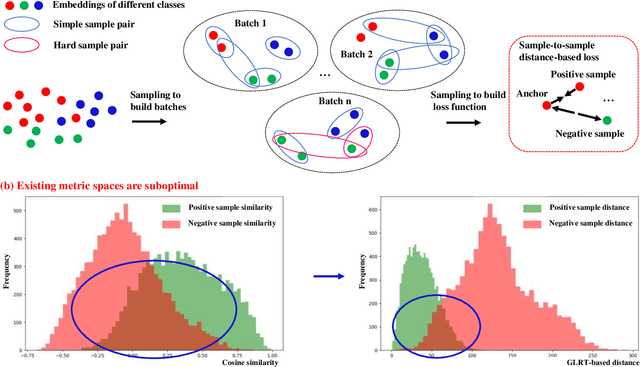
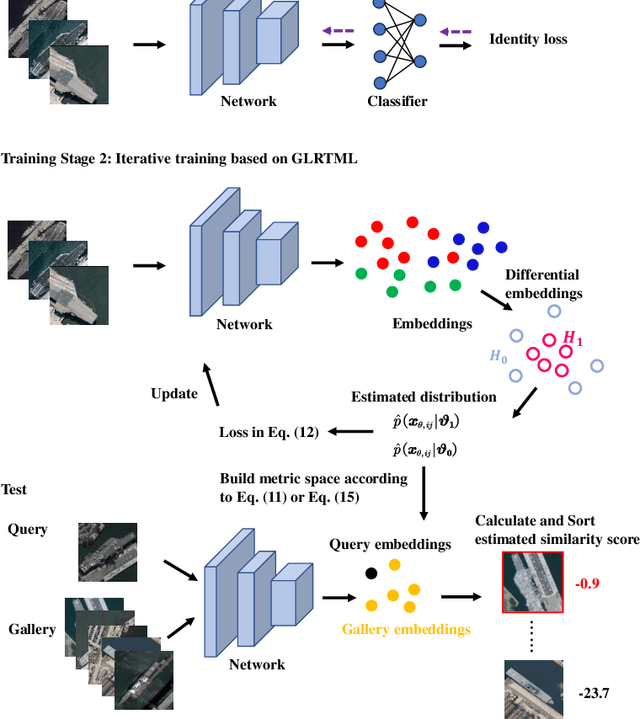
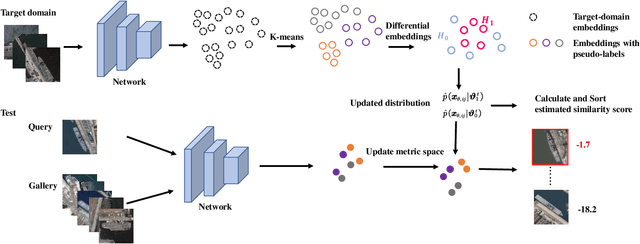
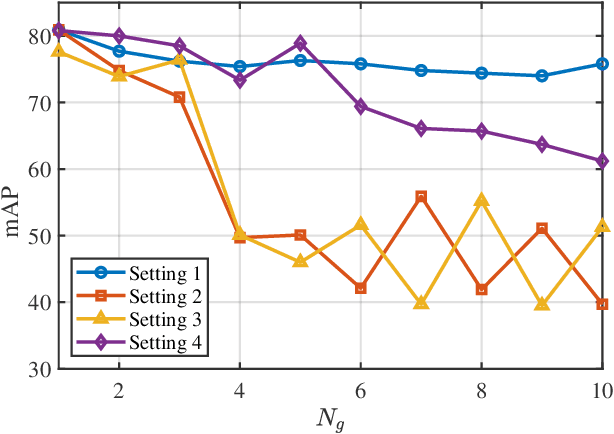
Abstract:With the improvement in the quantity and quality of remote sensing images, content-based remote sensing object retrieval (CBRSOR) has become an increasingly important topic. However, existing CBRSOR methods neglect the utilization of global statistical information during both training and test stages, which leads to the overfitting of neural networks to simple sample pairs of samples during training and suboptimal metric performance. Inspired by the Neyman-Pearson theorem, we propose a generalized likelihood ratio test-based metric learning (GLRTML) approach, which can estimate the relative difficulty of sample pairs by incorporating global data distribution information during training and test phases. This guides the network to focus more on difficult samples during the training process, thereby encourages the network to learn more discriminative feature embeddings. In addition, GLRT is a more effective than traditional metric space due to the utilization of global data distribution information. Accurately estimating the distribution of embeddings is critical for GLRTML. However, in real-world applications, there is often a distribution shift between the training and target domains, which diminishes the effectiveness of directly using the distribution estimated on training data. To address this issue, we propose the clustering pseudo-labels-based fast parameter adaptation (CPLFPA) method. CPLFPA efficiently estimates the distribution of embeddings in the target domain by clustering target domain instances and re-estimating the distribution parameters for GLRTML. We reorganize datasets for CBRSOR tasks based on fine-grained ship remote sensing image slices (FGSRSI-23) and military aircraft recognition (MAR20) datasets. Extensive experiments on these datasets demonstrate the effectiveness of our proposed GLRTML and CPLFPA.
Boosting Continual Learning of Vision-Language Models via Mixture-of-Experts Adapters
Mar 18, 2024Abstract:Continual learning can empower vision-language models to continuously acquire new knowledge, without the need for access to the entire historical dataset. However, mitigating the performance degradation in large-scale models is non-trivial due to (i) parameter shifts throughout lifelong learning and (ii) significant computational burdens associated with full-model tuning. In this work, we present a parameter-efficient continual learning framework to alleviate long-term forgetting in incremental learning with vision-language models. Our approach involves the dynamic expansion of a pre-trained CLIP model, through the integration of Mixture-of-Experts (MoE) adapters in response to new tasks. To preserve the zero-shot recognition capability of vision-language models, we further introduce a Distribution Discriminative Auto-Selector (DDAS) that automatically routes in-distribution and out-of-distribution inputs to the MoE Adapter and the original CLIP, respectively. Through extensive experiments across various settings, our proposed method consistently outperforms previous state-of-the-art approaches while concurrently reducing parameter training burdens by 60%. Our code locates at https://github.com/JiazuoYu/MoE-Adapters4CL
Magicremover: Tuning-free Text-guided Image inpainting with Diffusion Models
Oct 04, 2023Abstract:Image inpainting aims to fill in the missing pixels with visually coherent and semantically plausible content. Despite the great progress brought from deep generative models, this task still suffers from i. the difficulties in large-scale realistic data collection and costly model training; and ii. the intrinsic limitations in the traditionally user-defined binary masks on objects with unclear boundaries or transparent texture. In this paper, we propose MagicRemover, a tuning-free method that leverages the powerful diffusion models for text-guided image inpainting. We introduce an attention guidance strategy to constrain the sampling process of diffusion models, enabling the erasing of instructed areas and the restoration of occluded content. We further propose a classifier optimization algorithm to facilitate the denoising stability within less sampling steps. Extensive comparisons are conducted among our MagicRemover and state-of-the-art methods including quantitative evaluation and user study, demonstrating the significant improvement of MagicRemover on high-quality image inpainting. We will release our code at https://github.com/exisas/Magicremover.
 Add to Chrome
Add to Chrome Add to Firefox
Add to Firefox Add to Edge
Add to Edge